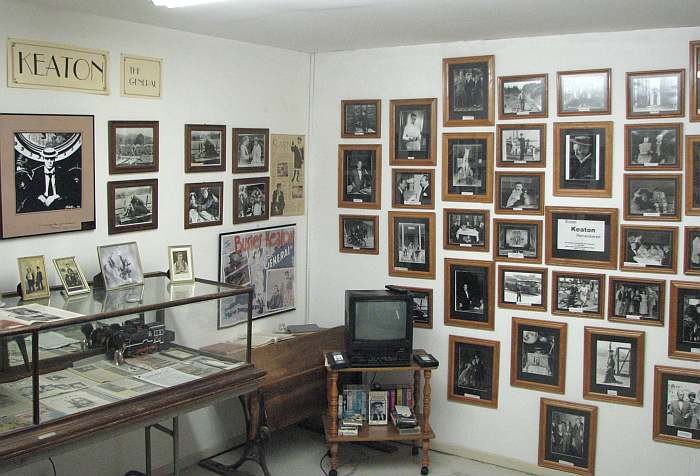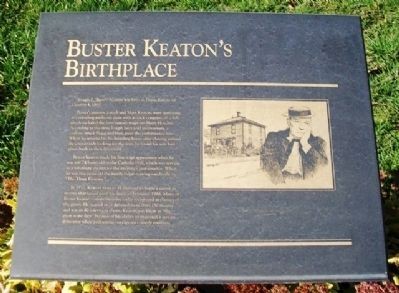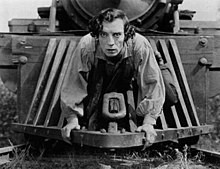The Buster Keaton Museum
Introduction
Text-to-speech Audio
This small, one-room museum houses a collection of memorabilia related to Buster Keaton, one of the most famous actors and comedians of the silent film era. Keaton was born in Piqua, Kansas in 1895, and this museum dates back to 1992 when residents of Iola, Kansas (a community close to Piqua) began hosting an annual event in celebration of Keaton’s life and work. As a result of these events, people began donating memorabilia such as movie posters, photographs, and tapes which are now being housed by the Buster Keaton Museum located in the Piqua Water Department.
Images
The Buster Keaton Museum

A Buster Keaton historical marker in Piqua, KS

The Three Keatons c. 1916

Buster Keaton in The General (1926)

Backstory and Context
Text-to-speech Audio
Keaton was born Joseph Frank Keaton in Piqua, Kansas in 1895. The star of many of the leading Hollywood movies in the 1920s, Buster Keaton was best known for physically demanding stunts. The actor's nickname "Buster" is often credited to Harry Houdini, who was billed alongside the Keatons during their vaudeville days. The legend says that Keaton had fallen down a flight of stairs at six months old and Houdini picked him up, noting that he was relatively unharmed and that he could “take a buster.” This story is almost certainly more legend than fact as the Keatons wouldn’t have known Houdini at that time, and it is more likely that the nickname was given to him by fellow vaudevillian George Pardey. Despite the inconsistencies, the story continues to enjoy staying power and Houdini claimed that he had come up with the nickname throughout his life. Like many legends, the story is based on a fundamental truth: Buster Keaton could take a hit. Part showman and part stuntman, Keaton's physicality thrilled audiences as he performed daring feats.
Buster Keaton’s entertainment career began in vaudeville, which was the most popular form of entertainment in America at the turn of the century. Beginning in the 1880s, vaudeville shows provided an eclectic array of entertainment from comedians and ventriloquists to musicians and dancers. Vaudeville shows, which featured a series of performances, swept America through the 1920s from small towns to some of the nation's largest venues such as the New York Palace Theater. Many well-known actors from early Hollywood started out in vaudeville, such as Cary Grant 's acrobatic performances to Fred Astaire's partnered dancing act with his sister. Buster Keaton was one of many vaudeville actors who would later grace the silver screen, and it all began with being part of his family’s vaudeville act.
Family acts were common during vaudeville, and child stars who rose to fame in this era often began by being part of these acts. Buster Keaton's family's act was far more popular in performances that feature their son, who began performing at age three. At just three years old, Keaton joined his parents’ vaudeville act which was renamed The Three Keatons. During the twenty years that he was involved in this act, Keaton learned the slapstick style of comedy that he would be remembered for. Onstage his father tossed him around, causing him to have to learn how to take trick falls in order to remain unharmed. By 1917, the act had broken up due to Keaton’s father’s alcoholism. The same year, Keaton joined the Broadway show “The Passing Show of 1917” but quit when he met another vaudeville star Roscoe “Fatty” Arbuckle. After being drafted in World War I and serving in France with the 40th Infantry, Keaton moved to Hollywood to work with Arbuckle in films. Keaton became known for his deadpan expression which earned him the moniker “The Great Stone Face” and the physical comedy he performed without camera tricks for which he is now remembered as one of the greatest acrobatic actors. Eventually, he took over Arbuckle’s production company when Arbuckle left to make movies with Paramount. Most of Keaton’s work was done in the 1920s, including “The Navigator” (1924), “The General” (1926), and “The Cameraman” (1928) among others completed throughout the decade. "The General", a Civil War-era comedy, is remembered as his best movie and one of the greatest to come out of the Silent era. However, he was less popular than his contemporaries Charlie Chapin and Harold Lloyd, which hurt his career.
In 1928, Keaton gave up his production company to work with MGM. He described this decision as his “worst mistake.” During his time with MGM, he was no longer writing the movies and they didn’t utilize his acrobatic talents completely. He attempted to adapt to the advent of talkies, but ultimately found his success on a downward trajectory. The 1930s were difficult years for Keaton. In 1932, his wife (his “Our Hospitality” (1923) co-star Natalie Talmadge) divorced him due to their different lifestyles and his alcoholism. The couple had married in 1921 and had two sons, Joseph and Robert, who changed their surnames to Talmadge following the divorce. After his divorce, Keaton's drinking became habitual and he was institutionalized for alcoholism. In 1933, Keaton married his nurse Mae Scriven but continued to suffer from alcoholism. The couple divorced in 1936 after Keaton was caught with another woman in a hotel in Santa Barbara. After undergoing aversion therapy, Keaton quit drinking for five years. On May 29th, 1940 he married Eleanor Norris who is credited with saving his life and career. Their marriage lasted until he died. It was also during the 1930s that Keaton was working as an uncredited writer on films for the Marx Brothers and Red Skelton. Eventually, he was dropped by MGM altogether due to his alcoholism.
During the 1940s, Keaton was working little and continued to struggle with his alcoholism. It wasn’t until 1953 that his career began to turn around. That year, he starred opposite Charlie Chaplin in Chaplin’s film “Limelight.” After this, Keaton began making frequent television appearances including an episode of “The Twilight Zone.” Audiences who had never seen his physical comedy style were taken by him and a Buster Keaton revival began in the 1950s. With his films again being shown in theaters, Keaton once again became regarded as one of the best actors of his era. In 1956, actor James Mason found reels of Keaton’s shorts in the house he’d purchased from Keaton and began preserving them. The following year, “The Buster Keaton Story” starring Donald O’Connor as Keaton was released and the revenue from that film pulled Keaton out of poverty. He was involved in several films throughout the early 1960s, with his last being “A Funny Thing Happened on the Way to the Forum” which was released in 1966. He died of lung cancer at the age of 70 that same year.
Sources
Buster Keaton Museum, Kansas Travel. Accessed October 22nd, 2022. http://www.kansastravel.org/busterkeatonmuseum.htm#map.
Buster Keaton Biography, Turner Classic Movies. Accessed October 22nd, 2022. https://www.tcm.com/tcmdb/person/99741%7C25179/Buster-Keaton/#biography.
American Masters: Buster Keaton, PBS. January 13th, 2000. Accessed October 22nd, 2022. https://www.pbs.org/wnet/americanmasters/buster-keaton-about-buster-keaton/644/.
"Buster Keaton's Second Wife Sues Him for Divorce." Reading Eagle (Reading, Pennsylvania) July 18th, 1935. .
Soren, David. Fred Astaire: 1930s Iconic Dancer, The American Vaudeville Museum. Accessed October 22nd, 2022. https://vaudeville.sites.arizona.edu/node/71.
Bastién, Angelica Jade. The Acrobatic Grace of Cary Grant, The Criterion Collection. February 11th, 2021. Accessed October 22nd, 2022. https://www.criterion.com/current/posts/7268-the-acrobatic-grace-of-cary-grant.
Kansas Travel
The Historical Marker Database
The Buster Keaton Society
